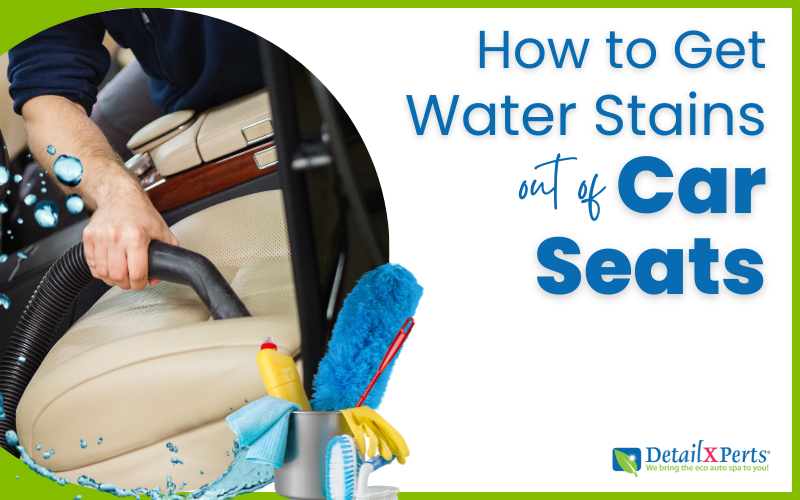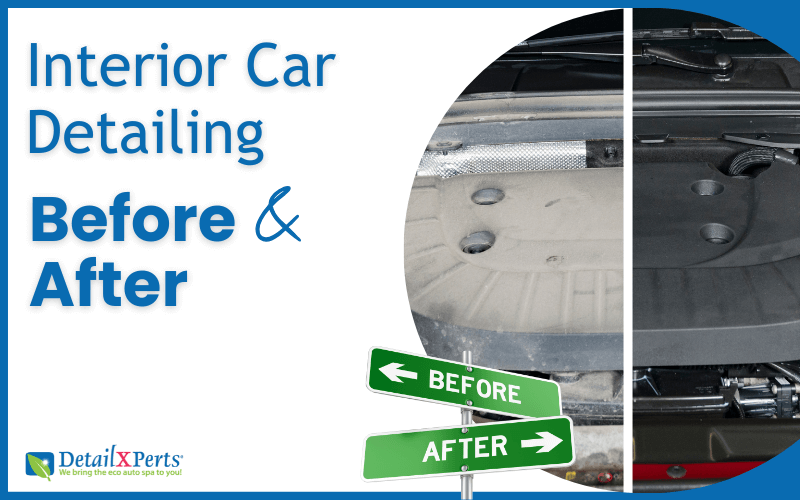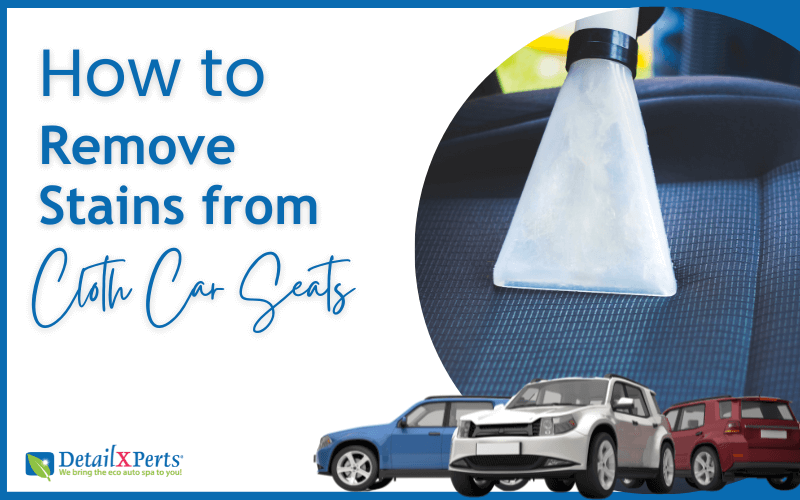It is good to know how to get water stains out of car seats because accidents do happen. For example, water bottle leaks and spillages, car windows left open in the rain, or wet clothes soaking into the seats can ruin the appearance of your vehicle. Also, unattended water stains can lead to mold and mildew. But you can address the problem with our step-by-step guide.
7 Steps to Remove Water Stains From Car Seats
Removing water stains on car seats is possible with our professional car interior detailing tips. Try to clean the water spots as soon as possible because these “fresher” spots are easier to remove than old water marks. Then, take the following steps:
Vacuum the Car Interior
First, remove any litter or belongings from wet seats and carpets. Otherwise, you may end up with more stains. Then use your car vacuum cleaner to get rid of crumbs and debris.
Use an Appropriate Car Upholstery Cleaner
Next, choose the best car interior detailing products for your car seat material, i.e. cloth, vinyl, suede, leather, etc. And instead of just targeting the water stains, clean the entire seat to get an even, freshly detailed look.
Follow the manufacturer’s instructions and always test your cleaning product on a small, discreet spot to ensure it doesn’t cause discoloration.
For deep cleaning or difficult stains, you might need to take further action. For instance, a steam cleaner for cars will do the trick. Steam effectively dissolves stains and sanitizes car interiors. Additionally, it is safe to use on different types of upholstery, including luxury leather.
Work the Cleaning Solution Into the Water Stain
Use a soft-bristled car wash brush to work the upholstery cleaner into the material. This step ensures you remove all traces of mineral deposits and leftover dirt and debris. Avoid scrubbing or rubbing the seats too hard to prevent damaging the material.
Homemade Remedy for Water Stains on Car Seats
Or you can use a homemade solution for stubborn water stains. Vinegar can help break down the mineral deposits in the stain. Do as follows:
- Mix equal parts white vinegar and water in a spray bottle.
- Spray the solution on the water stain and let it sit for a few minutes.
- Then, use a clean towel to blot the area.
- Repeat this process until the stain disappears.
Again, do a spot test first before tackling the water stain. You can use a vinegar mix on other stains, too. See our comprehensive guide on how to remove stains from car seats.
However, if you’re unsure about at-home tips and methods, professional car interior detailing service will give you peace of mind.
Rinse the Stain
Rinse the cleaned area with a clean, damp cloth to remove any residue. Don’t use too much water otherwise you’ll create a fresh stain.
If you have leather seats, consider applying a leather conditioner after cleaning to maintain the material’s suppleness and prevent it from drying out.
Note that removing water stains may not be enough to eliminate persistent musty mold odors. If this is a problem, see our guides on the following:
- How to remove mold from car interior.
- How to get bad smell out of car.
- How to get mildew smell out of car.
Dry the Seats
When you’ve successfully eliminated water stains on car seats, leave the car doors and windows open to allow the upholstery to air dry completely. You can also use a hair dryer to speed things up.
Vacuum to Finish
Once you have completed the steps on how to remove water stain from car seats, vacuum the seats again for a professional-looking finish.
Finally, we know that it’s not just water that makes a mess. So, if you need some additional car care tips, follow these guides:
- How to get blood out of car seat.
- How to get coffee stain out of car seat.
- How do you remove yellow smoke stains.
- How to get chocolate out of car seat.
Why Does Water Stain Car Seats?
When it comes to unsightly stains, water is a common culprit. But why does water stain car seats? Here are ways it can happen:
As water evaporates on seats, it can leave behind mineral deposits causing visible stains. For instance, hard water contains high levels of minerals, especially calcium and magnesium ions. So, these minerals end up on your car seats whenever there’s a spill, creating noticeable marks.
Water left to sit on car upholstery for too long can seep into fibers, causing stains and discoloration. If the water stain is extensive or particularly stubborn, your seats might need a deeper clean. For example, see how to steam clean car seats.
The materials used in car seat upholstery may react with the minerals in the water, exacerbating the staining process. For example, certain fabrics or leather may be more prone to discoloration or staining when they come into contact with minerals in the water. See our tips on how to get stains out of leather car seats.
If rainwater with high mineral content gets into your car, the evaporation of the water can result in visible stains on the fabric or leather. These stains may appear as white, chalky spots or discolorations.
Conclusion
In summary, now you know how to get water marks out of car seats in a few simple steps. But remember, prevention is always better than cure. So, dry off any wet items before placing them on seats. Also, you can add seat covers to protect your upholstery from stains, which might be useful if you travel with small children.
For dried-on water stains, steam cleaning solves the problem effectively. Our technicians use the latest equipment to guarantee a deeper clean. Moreover, this environmentally friendly method uses minimal water, which helps upholstery dry in no time after cleaning.








